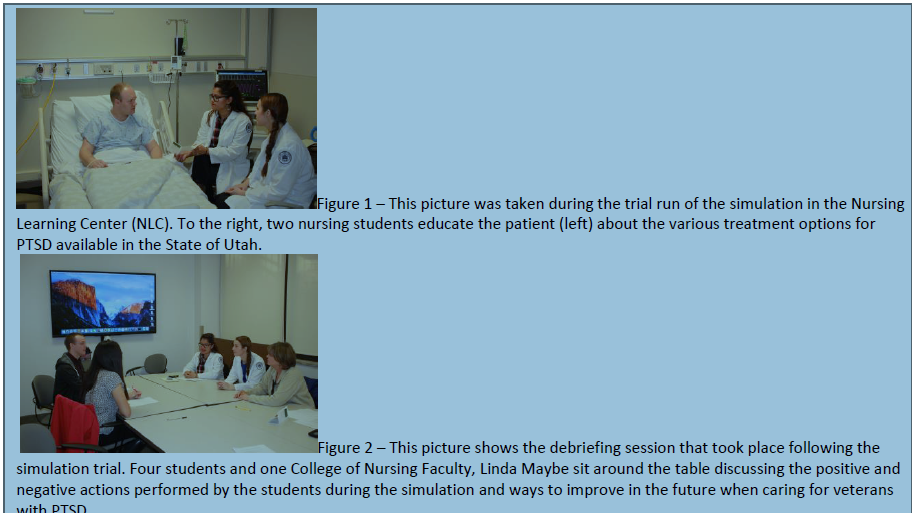Jennings, Deven
PostPost Post-traumatic Stress Disorder (PTSD) in the Veteran Population: An Education Simulation for Nursing Students
Faculty Mentor: Stacie Hunsaker, College of Nursing
Introduction
The veteran population receives health care in various locations outside of Veteran Affairs facilities. Current research supports that 18-30% of veterans suffer from PTSD. Census records show that in 2013, 19.3 million veterans living in the US, this means that nearly 3.5-5.8 million American veterans suffer from PTSD currently (Census.gov, 2014). The need for nurses to become more familiar with PTSD and specific nursing care related to PTSD is necessary to care for the diverse population we find in many health care settings. The purpose of this project was to create a simulated educational experience for nursing students in order to prepare them for caring for veteran patients with PTSD. The project will also help nursing students to fulfill the purposes of the simulation which are: 1) recognize PTSD with its associated signs and symptoms, 2) demonstrate how to implement therapeutic communication to patients experiencing hyper-anxiety situations, and 3) demonstrate knowledge concerning various support groups and treatment options for PTSD treatment and care.
Methodology
The simulation was created based on the available research concerning PTSD. After gathering over 20 research articles based on PTSD, available treatments, and educational approaches for educating students about PTSD, it was determined that more education for undergraduate student nurses was necessary. Seeing this hole in PTSD education, it was determined that an educational simulation could be created that would allow for student nursing to be taught about PTSD and relevant nursing cares and strategies. After analyzing the available research and creating a simulation patterned after other simulation examples, a trial run of the simulation was conducted in order to locate flaws in the simulation and determine the functionality of the simulation when applied to nursing courses.
Results
After completing the trial simulation, the faculty and student provided feedback concerning the simulation and potential revisions that could be made to improve the simulation in the future. After making necessary adjustments, the simulation outline was completed. The simulation and the associate results were presented at various conferences and venues including the Utah Conference on Undergraduate research at the University of Utah, the National Student Nurses Association Conference in Orlando, Florida, and the Western Institute of Nursing Conference in Anaheim, California. While presenting the results of the simulation, many faculty from other nursing institutes expressed interest in the simulation and potentially applying the simulation to their course curriculum. It was evident that other nursing professionals recognized the impact of this simulation and were eager to incorporate it into their nursing practice.
Discussion
While the preliminary evidence from the trial simulation were helpful, more must be done to prove the efficacy of the simulation. Future goals of the simulation are to gather more solid data on student and faculty perspectives on the simulation and its effects in nursing education. We also hope to take the simulation and completely apply it into the current course curriculum of the Psych and Mental Health class offered to student nurses at BYU-CON. Finally, we hope to take the simulation and continue to spread relevant information to inspire other institutes to take the simulation and apply it to their own courses as applicable. We hope that this simulation will not only effect student here at BYU, but will help increase awareness and education about PTSD in the veteran population to nursing students all across the country.
Conclusion
In conclusion, rates of PTSD among the veteran population are staggering. More must be done to prepare the future nurses of this country to care for and provide comfort to veterans with PTSD. As we seek to improve the knowledge of PTSD among nursing students, we will create a generation of nurses who are capable and prepared to help veterans as they recover from the psychological impacts of military service. This simulation is only one attempt to improve veteran care, but with this simulation and the accompanied evidence, we hope that others will see this work and build upon it to improve veteran care in the US.

